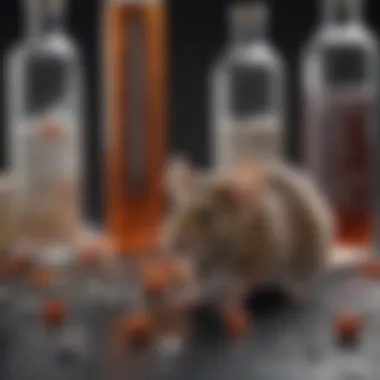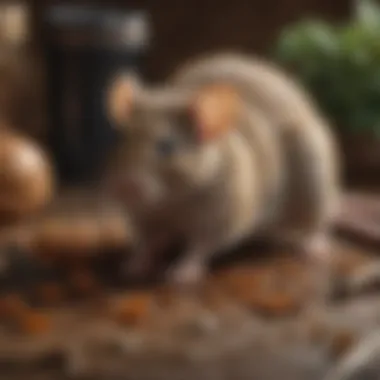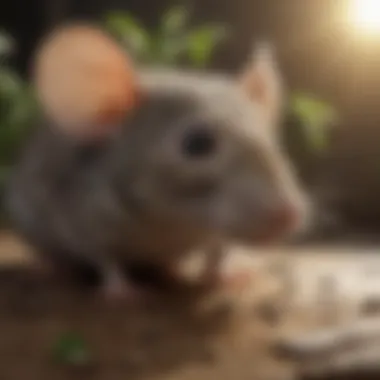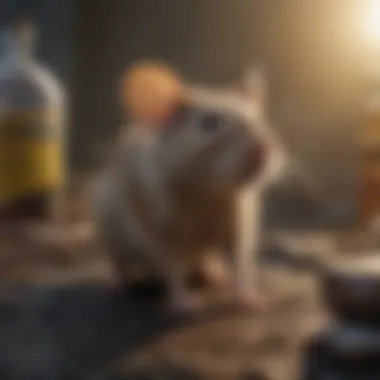Identifying Toxic Substances That Kill Mice


Intro
Mice are common pests in many households. These rodents can cause significant damage and pose health risks through contamination. Understanding their biology and behavior is essential for effective pest management. In this article, we will explore toxic substances that can kill mice when ingested, highlighting both chemical compounds and natural ingredients. By equipping homeowners and pest professionals with knowledge on these substances, we aim to improve pest control strategies while considering safety and environmental impact.
Understanding the Pest
Identification
Identifying mice correctly is the first step in managing them. Two common species are the house mouse and the field mouse. The house mouse has a small body, with a pointed snout and large ears. Its fur is typically brown or gray. In contrast, the field mouse is larger, with a more rounded face.
It is crucial to recognize their droppings, nests, and unusual scratching sounds. Understanding their behaviors can help in effective intervention.
Life Cycle
The life cycle of mice is rapid, allowing populations to grow quickly. A female mouse can give birth to a litter of five to six pups every three weeks, often leading to an exponential increase in numbers. Mice reach maturity in about six weeks. This short reproductive cycle means that prompt control measures are often necessary to prevent infestations from escalating.
Understanding Mice Behavior and Diet
Understanding the behavior and diet of mice is essential in the context of managing their populations effectively. Mice are opportunistic feeders, and their dietary habits directly influence the methods used to control them. Recognizing what attracts them and how their natural instincts govern their feeding ensures that any pest management strategy is well-targeted and humane.
In this article, we will explore the basic nutritional needs of mice, common food sources they exploit, and how you can identify their preferences. This knowledge not only aids in curbing infestations but also enhances awareness of potential hazards in our homes. Moreover, an informed approach minimizes unnecessary environmental impact while maintaining a balanced ecosystem.
Basic Nutritional Needs of Mice
Mice have specific dietary requirements that must be met to keep them healthy. Their nutritional needs include proteins, carbohydrates, fats, vitamins, and minerals. A balanced diet is crucial, particularly in the early stages of life when mice are growing and developing.
- Proteins are essential for growth, maintenance, and reproduction. Mice require a diet rich in protein for muscle development.
- Carbohydrates provide energy. Seeds, grains, and fruits are excellent sources.
- Fats are also important, as they store energy and aid in cell function.
- Essential vitamins and minerals are necessary for various metabolic processes. For example, calcium is vital for bone health.
Finally, water is a crucial element of any diet, as hydration supports all bodily functions. Without sufficient water intake, mice cannot thrive, and this can influence their behaviors and health significantly.
Common Food Sources for Mice
Mice are highly adaptable when it comes to food sources. They often scavenge and take advantage of human food leftovers or easily accessible items. Common food sources include:
- Grains and cereals: Typically found in kitchens and pantries.
- Fruits and vegetables: These are frequently left out or damaged in gardens.
- Seeds and nuts: Mice are excellent at locating these in the wild, and they consume whatever they can find.
- Human food waste: Mice are known to rummage through garbage bins for easy meals.
Understanding where mice find their food can help homeowners protect their homes from infestations. Effective sealing of food sources and waste disposal methods promotes a less hospitable environment for them.
Identifying Food Preferences
To control mouse populations effectively, identifying their food preferences is crucial. Mice may show distinct inclinations towards different food types. Here are ways to assess their preferences:
- Observation: Monitoring where mice eat can tell you what they prefer. Droppings or nibble marks can point to favorite snacks.
- Bait testing: Setting up different types of bait can reveal which ones attract mice the most. This can be achieved by using all different kinds of food items to determine their favorites.
- Environment analysis: Mice tend to frequent spaces that provide easy access to their preferred foods. Identify and eliminate these nearby sources.
Once you understand what attracts mice specifically, you can tailor removal strategies to make your home less appealing. Protecting food supplies and tidying up living spaces can help maintain an effective pest management strategy.
Chemical Compounds Lethal to Mice
Understanding chemical compounds that are lethal to mice is crucial for anyone dealing with rodent infestations. Knowing these substances can help in establishing effective pest control methods while prioritizing human and pet safety. Chemical compounds vary widely in their mechanisms and effectiveness. This section will delve into some prominent examples, emphasizing both risks and benefits, while delivering important guidelines for responsible usage.
Anticoagulants
Mechanism of Action
Anticoagulants hinder the blood clotting process in mice. They block the action of vitamin K, essential for synthesizing proteins necessary for blood coagulation. This results in uncontrolled bleeding, ultimately leading to death. Their effectiveness is one reason many professionals favor these compounds in pest control. However, they require careful handling and adherence to guidelines to minimize risks to non-target species.
Types of Anticoagulants
There are several types of anticoagulants, including bromadiolone, brodifacoum, and difenacoum. Each variety has unique properties influencing its application. For instance, brodifacoum boasts a long-lasting effect, making it effective for extended pest control periods. Conversely, some anticoagulants pose higher secondary poisoning risks to non-target wildlife. Understanding these dynamics is essential for choosing the right agent for specific situations.
Long-term Effects
Using anticoagulants can lead to long-term environmental issues. These substances remain in the ecosystem, accumulating in predator species that might consume poisoned rodents. While they are significant for controlling mouse populations, one must weigh their potential consequences against the benefits. Awareness of these effects can guide homeowners and professionals alike in making informed decisions about their usage.
Cholecalciferol
How It Works


Cholecalciferol, or vitamin D3, works by increasing calcium absorption in the intestines, leading to toxic levels in the bloodstream. This mechanism is notably swift and effective in killing mice. It operates differently from anticoagulants, making it a viable alternative for pest management strategies. However, the risks associated with its use necessitate careful consideration.
Risks Involved
Cholecalciferol poses risks, especially around children and pets. It can lead to hypercalcemia, which may cause organ damage if ingested by non-target animals. Hence, awareness of its toxicity is crucial. Users must weigh the risks against the effectiveness, ensuring safeguards are in place to prevent accidental exposure.
Environmental Impact
The environmental impact of cholecalciferol is also significant. It does not persist in the environment like some anticoagulants. However, its rapid action and potency can lead to detrimental effects on local wildlife. Understanding these factors helps formulate a more comprehensive approach to managing rodent populations responsibly.
Bromethalin
Effect on the Nervous System
Bromethalin acts on the central nervous system by disrupting cellular metabolism. This property categorizes it as a neurotoxin, causing paralysis and eventual death. This mode of action can be particularly effective when other poisons fail, and it has no antidote, which raises concerns about its use.
Symptoms of Poisoning
Mice exposed to bromethalin may exhibit symptoms such as tremors, seizures, and lack of movement. Being able to identify these symptoms early can be invaluable for pest control professionals. They can act swiftly to address the problem before it escalates, ensuring the management strategy's overall effectiveness.
Usage Guidelines
When using bromethalin, it is crucial to adhere to specific guidelines. Proper placement and quantity can reduce the risks associated with this potent toxin. Users should be meticulous about application areas to prevent unintended contact by non-target species. The advantages of rapid action must be balanced with the potential liabilities in usage.
Natural Substances Toxic to Mice
Understanding natural substances that can harm mice is essential when dealing with pest management. These substances often provide safer alternatives compared to chemical poisons. Homeowners and pest control professionals must recognize how common natural items can effectively deter mice, minimize risks to non-target species, and reduce environmental impact. Focusing on natural solutions aligns with a growing preference for sustainability in pest control, offering a more conscientious approach to maintaining homes free of pests.
Essential Oils
Essential oils are gaining attention for their potential to repel and eliminate mice without the use of harsh chemicals. Their concentrated nature makes them effective deterrents.
Peppermint Oil
Peppermint oil stands out for its strong scent which mice find overwhelming. The primary component, menthol, may irritate their olfactory senses. This characteristic makes peppermint oil a popular choice. However, its effectiveness may diminish over time if not reapplied regularly. Homeowners often appreciate its fresh scent, but it will not kill mice; it primarily serves as a repellent.
Clove Oil
Clove oil is another natural option for pest control. The active ingredient in clove oil is eugenol, known for its strong aroma. Mice tend to avoid areas treated with clove oil, making it a beneficial addition. One downside is that the strong scent can also be overpowering for humans if used in large quantities. Nonetheless, clove oil provides a more natural alternative for pest management.
Usage Considerations
Using essential oils requires careful application. Knowing the correct dilution rate and application method is crucial to maximizing effectiveness. They will not function as a standalone solution and may need to be used in conjunction with other deterrents. Homeowners should be aware of potential allergies or sensitivities among residents, as essential oils can cause reactions in some individuals.
Salt
Salt is a common household item that can be toxic to mice when ingested in large quantities. While used for seasoning and preservation, its effects on rodents are worth noting.
Mechanism of Action
The mechanism by which salt affects mice involves dehydration. High salt intake leads to an imbalance in fluids, causing critical hydration issues. This feature can be advantageous for pest control. However, the practicality of using salt as a lethal agent is questionable. It may not be effective as a sole method due to its unpalatable nature.
Risks of Overconsumption
Ingesting high amounts of salt poses risks, not only to mice but also to pets and humans. Care must be taken to avoid accidental poisoning of non-target species. Mice may develop an aversion to food containing salt, which could create challenges for traditional bait options. Using salt as a deterrent must be done judiciously to avoid unintended consequences.
Practical Applications
Salt should be applied sparingly in areas frequented by mice. Sprinkling it in potential entry points can help deter them, but it must be part of a comprehensive strategy. It is not a straightforward solution and should be considered a supplementary option in conjunction with the more effective measures.
Boric Acid
Boric acid is recognized in pest management for its effectiveness against various pests, including mice.
How It Affects Mice
When ingested, boric acid disrupts the digestive system, leading to dehydration and eventual death. It is considered practical due to its low toxicity to humans and pets when used properly. Boric acid is an attractive choice for those who seek a less harmful alternative for managing rodents. Nonetheless, it requires precise application to be effective.


Safe Application Strategies
Applying boric acid safely involves placing it in hard-to-reach locations where pets and children cannot access it. Homeowners must ensure that it is used according to recommended guidelines to minimize risks. It can be effective when in a bait form that attracts mice, making a strategic approach essential for success.
Disposal Considerations
Disposing of boric acid requires caution. It should never be thrown in regular trash as it can pose risks to wildlife. Educating oneself on local regulations regarding the disposal of pesticides is crucial. Proper disposal methods help maintain ecological balance and prevent accidental harm to non-target species.
Food Items That Can Kill Mice
The discussion of food items that can kill mice is critical in understanding potential dangers in homes. Mice are common pests, and knowing what foods are toxic to them can aid homeowners in taking preventive measures. Not all food is inherently dangerous; however, certain items can be lethally harmful if ingested. This section offers insights into such food items, outlining their mechanisms of toxicity and practical implications. Understanding these can help in informing pest management strategies that align with safety and environmental considerations.
Chocolate
Theobromine Toxicity
Chocolate contains a compound called theobromine, which is highly toxic to mice. Theobromine affects the central nervous system and cardiovascular system of these animals. Unlike humans, mice metabolize theobromine much slower, which increases its toxicity. This characteristic of theobromine makes chocolate a dangerous substance around homes where mice may be present. Homeowners should be aware that even small amounts can be fatal.
Symptoms in Mice
When mice consume chocolate, they may experience various symptoms. These symptoms can include hyperactivity, increased heart rate, and digestive issues. Identifying these symptoms promptly is vital for taking necessary actions. Being able to recognize signs of theobromine toxicity allows for quick responses, potentially saving lives. Homeowners should familiarize themselves with these symptoms to act quickly if needed.
Recommended Precautions
It is crucial to take specific precautions regarding chocolate in households. Ensure that chocolate products are stored securely. Additionally, educate family members, especially children, about the dangers of leaving chocolate unattended. Maintaining a clean environment reduces the risk of mice accessing such harmful food. Awareness of these recommended practices can significantly minimize poisoning risks.
Onions and Garlic
Mechanisms of Toxicity
Onions and garlic are also very harmful to mice due to the presence of thiosulfate and other compounds. Thiosulfate can cause oxidative damage to red blood cells in mice, leading to hemolytic anemia. Understanding this mechanism highlights that common kitchen staples can pose significant risks. Homeowners should recognize these foods as potential hazards in any pest control strategy.
Identifying Food Hazards
Identifying food hazards, such as onions and garlic, is essential in a domestic context. Knowing where these items are stored and ensuring they are not accessible to mice is a critical step. This awareness helps prevent accidental ingestion by unwanted pests in the home. Steps for a thorough kitchen inspection can be part of a consistent pest management regimen.
Alternative Dietary Options
Considering alternative dietary options for households is prudent. Should mice invade, it is beneficial to know what foods they are attracted to versus what to eliminate. Research into safer food sources can help homeowners develop better strategies. Substituting sensitive items with alternatives ensures that risks are minimized while pest management is effective.
Nutmeg
Toxic Components
Nutmeg contains a compound called myristicin, which is toxic to mice. Myristicin affects the nervous system and can lead to severe consequences upon ingestion. Acknowledging this unique feature helps highlight how readily available spices can be hazardous. Homeowners should be aware of such risks, especially during cooking or baking which may invite rodent activity.
Potential Risks
Consumption of nutmeg can result in various health risks for mice. These include neurological disturbances and potential seizures. Identifying these risks is vital to understanding how seemingly benign spices can contribute to harmful encounters. Homeowners should be vigilant about the presence of nutmeg and ensure it is not accessible to mice.
Sourcing Safe Alternatives
Sourcing safe alternatives to nutmeg is necessary for kitchen safety. Utilizing different spices can provide both flavor and safety. It is also important to be knowledgeable about what items are non-toxic and safe for both humans and pets. Homeowners can explore various herbs and spices that do not carry these risks and can contribute positively to systems of pest control.
Impact on the Ecosystem
The use of toxic substances, whether chemical or natural, can have far-reaching consequences beyond just the immediate goal of eliminating mice. Understanding the impact on the ecosystem is crucial in any effective pest management strategy. This section will delve into the various effects that such substances can have not only on target species but also on the overall health of the environment.
Effects of Chemical Poisons
Secondary Poisoning Risks
Secondary poisoning occurs when non-target organisms ingest poisons indirectly, often by consuming prey that has been poisoned. This is significant as it can disrupt entire food chains, affecting predators and scavengers. For example, birds of prey or pets may be affected. The key characteristic of secondary poisoning is its potential to cause casualties among various species that were not the intended targets of the poisons. This makes the usage of such substances less favorable among environmentally conscious pest control methods. Understanding secondary poisoning risks allows one to consider safer alternatives that might prevent broader ecological harm.
Effects on Non-target Species
Chemical poisons can inadvertently harm species that do not pose a threat to human habitats. The effects on non-target species can disrupt local biodiversity and reduce populations of beneficial organisms. The unique feature of these effects is their unpredictability, as various species may react differently to the same toxins. The disadvantage is that these impacts are often overlooked until noticeable declines in certain animal populations occur. Identifying these effects leads to more responsible choices in pest management that support ecological balance.


Long-term Environmental Consequences
The long-term environmental consequences of using toxic substances can be severe. Many poisons may persist in the environment, accumulating in soil and water. This can harm plant life and enter the food chain, affecting a wide range of species, including humans. The characteristic of these consequences is their gradual manifestation. Since they may take time to build up, the effects can often be missed in short-term studies. Therefore, the long-term impact demands consideration for sustainable practices in pest control to minimize detrimental effects on the ecosystem.
Market Alternatives
Environmental Safety
When examining market alternatives, environmental safety is paramount. This includes assessing the toxicity of products not only to mice but also to other wildlife and plants. A key characteristic of environmentally safe products is their biodegradable properties, which minimizes long-lasting ecological harm. Highlighting environmental safety acknowledges the need for a balanced approach where pest management does not come at the cost of environmental degradation.
Evaluate Effectiveness
Evaluating effectiveness is essential when considering alternatives in pest control. Products must not only be safe but also effective in controlling rodent populations. The unique feature here lies in the balance of achieving efficacy while minimizing drawbacks like secondary poisoning or resistance development in rodent populations. Understanding how various alternatives stack up against traditional poisons informs better choices for consumers.
Consumer Responsibility
Consumer responsibility plays a critical role in making informed decisions for pest management. Individuals must consider the consequences of their choices on the environment and local ecosystems. The characteristic of consumer responsibility is its focus on awareness and education. Consumers can influence market trends toward safer alternatives by choosing products that promote ecological health. This has the potential to foster a collective shift towards more sustainable pest control practices.
Best Practices for Pest Management
Effective pest management is crucial for maintaining a healthy environment in and around homes. The approach to dealing with pests, especially mice, should balance every necessary element, from health considerations to legal regulations. This article emphasizes the importance of integrated pest management strategies and DIY solutions, focusing on practical yet environmentally friendly methods to manage rodent populations. Homeowners should adopt these practices to ensure both effectiveness and safety while minimizing risks associated with chemical substance use.
Integrated Pest Management Strategies
Using Natural Deterrents
Natural deterrents can serve as a valuable component of rodent management. They are substances derived from plants or essential oils, like peppermint, that mice find unpleasant. Incorporating these into pest management is a more humane option and contributes to a sustainable approach.
One key characteristic of using natural deterrents is their safety. Unlike synthetic chemicals, they pose lower risks to humans and pets, making them a popular choice among environmentally conscious homeowners. A unique feature of these products is that they can often be found in common households, requiring no elaborate preparations.
However, while effective, natural deterrents may not provide a complete solution. Their efficacy can vary, influenced by factors such as concentration and environmental conditions, suggesting they are best used as part of a broader strategy.
Monitoring Rodent Activity
Monitoring rodent activity is essential in any pest management plan. By observing signs of mouse presence, homeowners can identify problem areas and take systematic steps to address these issues. The ability to track changes over time helps in developing targeted strategies that suit specific situations.
A significant benefit of monitoring is its proactive nature. By identifying a rodent problem early, it’s easier to prevent escalation. Moreover, this approach allows homeowners to gauge the effectiveness of applied methods over time.
Nevertheless, it requires consistent effort and awareness. Failure to regularly monitor can lead to an unnoticed increase in mouse populations, which may complicate management efforts and escalate costs.
Community Awareness
Community awareness plays a fundamental role in successful pest management. When neighborhoods collectively understand the implications of rodent infestations, they tend to cooperate more effectively to implement control measures. Promoting awareness can lead to shared resources and strategies, fostering an informed society.
The key characteristic of this approach is that knowledge is power. When residential communities are informed about potential risks, they are better prepared to manage the associated threats effectively. The unique aspect of fostering community awareness is that it often leads to improved condition overall, not only reducing rodent numbers but also encouraging responsible practices among residents.
Although community engagement can offer significant advantages, it may also encounter challenges. Different levels of commitment among residents can hinder overall effectiveness and lead to inconsistent practices.
DIY Solutions and Precautions
Safe Handling of Chemicals
Chemical control measures remain a common aspect of pest management. However, safe handling practices are critical when employing these substances. Proper understanding and careful management can mitigate potential risks to humans, pets, and the environment.
The primary characteristic of safe handling is minimizing hazards. Training individuals in the responsible use of pest control chemicals ensures a greater degree of safety and compliance with regulations. A unique feature of this approach is that it does not only focus on immediate pest control but also emphasizes long-term responsibility to avoid future complications.
Despite these benefits, reliance on chemicals should not overshadow more sustainable methods. Overuse and improper handling can lead to various health and environmental risks, which should always be considered.
Public Health Considerations
Public health considerations are paramount when addressing rodent infestations. These pests can carry diseases that pose risks not only to households but also to entire neighborhoods. Recognizing these health aspects reinforces the importance of immediate and effective pest control measures.
One notable characteristic of prioritizing public health is its community-focused nature. Strategies developed with a Public health perspective often lead to collective action, ensuring collective well-being. This focus helps raise awareness regarding the dangers posed by uncontrolled rodent populations, emphasizing preventative measures.
However, prioritization of public health can sometimes conflict with economic interests. Understanding that a balanced approach is essential will be necessary to meet the needs of both individual households and the community as a whole.
Educating Others
Educating others about pest management practices fosters a shared responsibility in handling rodent infestation. By sharing knowledge on effective strategies and preventive measures, communities empower each other to combat pest issues more effectively.
The key characteristic of this educational approach is its adaptability. Knowledge sharing can occur in various formats, from workshops to social media campaigns. A unique element is that educating others leads to a culture of proactive engagement, promoting best practices in pest management across communities.
Nonetheless, achieving widespread education may require significant effort. Variations in knowledge levels among different groups can create gaps in understanding, which must be addressed for effective implementation.
In summary, the approach to pest management should combine safe practices, awareness, and education to ensure an effective and humane strategy against rodent populations.







